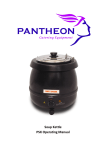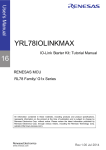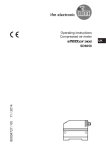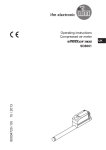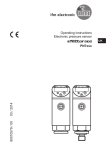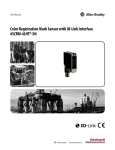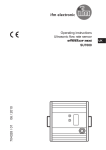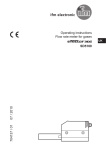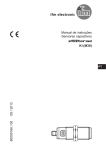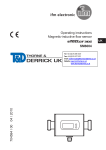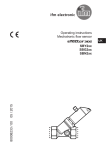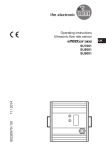Download Operating instructions Magnetic-inductive flow meter
Transcript
Operating instructions Magnetic-inductive flow meter UK 706341 / 00 05 / 2014 SM2001 SM9001 Contents 1 Preliminary note���������������������������������������������������������������������������������������������������5 1.1 Symbols used������������������������������������������������������������������������������������������������5 1.2 Warning signs used���������������������������������������������������������������������������������������5 2 Safety instructions�����������������������������������������������������������������������������������������������5 3 Functions and features����������������������������������������������������������������������������������������6 4 Function���������������������������������������������������������������������������������������������������������������6 4.1 Measuring principle for volumetric flow monitoring����������������������������������������6 4.2 Processing of the measured signals��������������������������������������������������������������7 4.3 Volumetric flow monitoring�����������������������������������������������������������������������������8 4.3.1 Volumetric flow quantity������������������������������������������������������������������������8 4.3.2 Direction of flow������������������������������������������������������������������������������������8 4.4 Consumed quantity monitoring (totaliser function)����������������������������������������8 4.4.1 Consumed quantity monitoring with pulse output���������������������������������9 4.4.2 Consumed quantity monitoring with preset counter�����������������������������9 4.5 Temperature monitoring�������������������������������������������������������������������������������10 4.6 Empty pipe detection�����������������������������������������������������������������������������������10 4.7 Volumetric flow or temperature monitoring / switching function�������������������10 4.7.1 Hysteresis function����������������������������������������������������������������������������� 11 4.7.2 Window function��������������������������������������������������������������������������������� 11 4.8 Volumetric flow or temperature monitoring / analogue function�������������������12 4.8.1 Current output�������������������������������������������������������������������������������������12 4.8.2 Voltage output�������������������������������������������������������������������������������������13 4.9 Volumetric flow monitoring / frequency output���������������������������������������������14 4.10 Start-up delay��������������������������������������������������������������������������������������������14 4.11 Low flow cut-off (LFC)��������������������������������������������������������������������������������16 4.12 Simulation��������������������������������������������������������������������������������������������������16 5 Installation���������������������������������������������������������������������������������������������������������17 5.1 Recommended installation position�������������������������������������������������������������17 5.2 Not recommended installation position��������������������������������������������������������19 5.3 Grounding����������������������������������������������������������������������������������������������������20 5.4 Installation in pipes��������������������������������������������������������������������������������������20 6 Electrical connection������������������������������������������������������������������������������������������21 7 Operating and display elements������������������������������������������������������������������������22 2 8 Menu �����������������������������������������������������������������������������������������������������������������23 8.1 Process value display����������������������������������������������������������������������������������23 8.2 Main menu���������������������������������������������������������������������������������������������������24 8.2.1 Explanation main menu����������������������������������������������������������������������25 8.3 Extended functions – Basic settings������������������������������������������������������������26 8.3.1 Explanation extended functions (EF)��������������������������������������������������27 8.3.2 Submenu basic settings (CFG)����������������������������������������������������������27 8.4 Extended functions – Min/max memory – Emtpy pipe – Simulation������������28 8.4.1 Explanation extended functions (EF)��������������������������������������������������29 8.4.2 Submenu min/max memory (MEM)����������������������������������������������������29 UK 8.4.3 Submenu empty pipe (EPD)���������������������������������������������������������������29 8.4.4 Submenu simulation (SIM)�����������������������������������������������������������������29 9 Set-up����������������������������������������������������������������������������������������������������������������30 10 Parameter setting��������������������������������������������������������������������������������������������30 10.1 IO-Link�������������������������������������������������������������������������������������������������������31 10.1.1 General information��������������������������������������������������������������������������31 10.1.2 Device-specific information���������������������������������������������������������������31 10.1.3 Parameter setting tools���������������������������������������������������������������������31 10.2 Parameter setting in general���������������������������������������������������������������������32 10.2.1 Switching between the menu levels�������������������������������������������������33 10.2.2 Locking / unlocking���������������������������������������������������������������������������33 10.2.3 Timeout���������������������������������������������������������������������������������������������33 10.3 Settings for consumed quantity monitoring�����������������������������������������������33 10.3.1 Settings for limit value monitoring with OUT1�����������������������������������33 10.3.2 Settings for limit value monitoring with OUT2�����������������������������������34 10.3.3 Setting the analogue value for volumetric flow���������������������������������34 10.3.4 Setting the frequency value for volumetric flow��������������������������������34 10.4 Settings for consumed quantity monitoring�����������������������������������������������34 10.4.1 Settings for quantity monitoring via pulse output������������������������������34 10.4.2 Settings for quantity monitoring via the preset counter��������������������35 10.4.3 Setting the pulse value���������������������������������������������������������������������35 10.4.4 Manual counter reset������������������������������������������������������������������������35 10.4.5 Time-controlled counter-reset�����������������������������������������������������������36 10.4.6 Deactivation of the counter reset������������������������������������������������������36 10.4.7 Configure counter reset using an external signal�����������������������������36 10.5 Settings for temperature monitoring����������������������������������������������������������36 3 10.5.1 Settings for limit value monitoring with OUT2�����������������������������������36 10.5.2 Setting the analogue value for temperature�������������������������������������36 10.6 User settings (optional)������������������������������������������������������������������������������37 10.6.1 Setting of the standard unit of measurement for volumetric flow������37 10.6.2 Configuration of the standard display�����������������������������������������������37 10.6.3 Changing the direction of the flow rate measurement����������������������37 10.6.4 Setting the output logic���������������������������������������������������������������������37 10.6.5 Setting the start-up delay������������������������������������������������������������������37 10.6.6 Setting the measured value damping�����������������������������������������������37 10.6.7 Setting the error behaviour of the outputs����������������������������������������38 10.6.8 Configuring the empty pipe detection as diagnostic output��������������38 10.6.9 Activating / deactivating empty pipe detection����������������������������������38 10.6.10 Time-delay empty pipe detection����������������������������������������������������38 10.6.11 Setting of the empty pipe detection������������������������������������������������39 10.6.12 Setting the counting method of the totaliser�����������������������������������39 10.6.13 Setting the low flow cut-off��������������������������������������������������������������39 10.7 Service functions���������������������������������������������������������������������������������������39 10.7.1 Reading the min/max values for the volumetric flow������������������������39 10.7.2 Reading the min/max values for the temperature�����������������������������39 10.7.3 Simulation menu�������������������������������������������������������������������������������40 10.7.4 Resetting all parameters to factory setting���������������������������������������40 11 Operation���������������������������������������������������������������������������������������������������������41 11.1 Reading the process value������������������������������������������������������������������������41 11.2 Reading the parameter value���������������������������������������������������������������������42 11.3 Error indications�����������������������������������������������������������������������������������������43 12 Technical data��������������������������������������������������������������������������������������������������43 13 Factory setting�������������������������������������������������������������������������������������������������44 4 1 Preliminary note 1.1 Symbols used ► > […] → Instructions Reaction, result Designation of pushbuttons, buttons or indications Cross-reference Important note Non-compliance can result in malfunction or interference. Information Supplementary note. UK 1.2 Warning signs used CAUTION Warning of personal injury. Slight reversible injuries may result. 2 Safety instructions • Please read this document prior to set-up of the unit. Ensure that the product is suitable for your application without any restrictions. • If the operating instructions or the technical data are not adhered to, personal injury and/or damage to property can occur. • Improper or non-intended use may lead to malfunctions of the unit or to unwanted effects in your application. That is why installation, electrical connection, set-up, operation and maintenance of the unit must only be carried out by qualified personnel authorised by the machine operator. • In order to guarantee the correct condition of the device for the operating time it is necessary to use the device only for media to which the wetted materials are sufficiently resistant (→ Technical data). • The responsibility whether the measurement devices are suitable for the respective application lies with the operator. The manufacturer assumes no liability for consequences of misuse by the operator. Improper installation and use of the devices result in a loss of the warranty claims. 5 • For medium temperatures above 122 °F some parts of the housing can heat up to over 149 °F. Moreover, during installation or in case of a fault (e.g. housing damage) media under high pressure or hot media can leak from the system. To avoid personal injury, take the following measures: ►► Install the unit according to the applicable rules and regulations. ►► Ensure that the system is free of pressure during installation. ►► Protect the housing against contact with flammable substances and unintentional contact. To do so, equip the unit with suitable protection (e.g. protective cover). ►► Do not press the pushbuttons manually; instead use another object (e.g. ballpoint pen). 3 Functions and features Pressure Equipment Directive (PED): The units comply with section 3, article 3 of the Directive 97/23/EC and must be designed and manufactured for non-superheated liquids of group 2 fluids in accordance with the sound engineering practice. The unit monitors liquid media. The unit detects the 3 process categories volumetric flow quantity, consumed quantity and medium temperature. Application area Conductive liquids with the following properties: • Conductivity: ≥ 20 µS/cm • Viscosity: < 70 cST at 104 °F 4 Function 4.1 Measuring principle for volumetric flow monitoring The magnetic-inductive measuring principle means that a magnetic field is generated in the measuring pipe via current-carrying coils. When a conductive medium flows through the measuring pipe, the ions therein are diverted perpendicularly to the magnetic field. Positive and negative charge carriers flow in opposite directions. The voltage induced is measured by two electrodes that are in contact with the medium. This signal voltage is directly proportional to the average flow velocity. The volumetric flow quantity is derived from the inside pipe diameter. 6 1: 2: 3: 4: 5: 1 2 Field coil Measuring pipe Electrode Charge carrier in the medium Magnetic field 3 4 UK 5 Both electrodes must be wetted by the medium. Otherwise the signal [SEnS] for empty pipe is provided, if empty pipe detection is enabled. 4.2 Processing of the measured signals The unit displays the current process values. It generates 2 output signals according to the parameter setting. OUT1/IO-Link: 5 selection options -- Switching signal for volumetric flow limit values -- or frequency signal for volumetric flow quantity -- or pulse signal for quantity meter -- or switching signal for preset counter -- or switching signal for empty pipe detection Parameter setting (→ 10.3.1) (→ 10.3.4) (→ 10.4.1) (→ 10.4.2) (→ 10.6.9) OUT2: 6 selection options -- Switching signal for volumetric flow limit values -- or switching signal for temperature limit value -- or analogue signal for volumetric flow quantity -- or analogue signal for temperature -- or input for external reset signal (InD) -- or switching signal for empty pipe detection Parameter setting (→ 10.3.2) (→ 10.5.1) (→ 10.3.3) (→ 10.5.2) (→ 10.4.7) (→ 10.6.9) 7 4.3 Volumetric flow monitoring 4.3.1 Volumetric flow quantity The signals for measuring the volumetric flow quantity can be provided as follows: 1. Two switching signals for volumetric flow quantity limit values on output 1 and output 2. On the switching functions → 4.7. 2. A frequency signal (10 Hz...10 kHz) on output 1. On the frequency functions → 4.9. 3. An analogue signal (4...20 mA or 0...10 V) on output 2. On the analogue functions → 4.8. 4.3.2 Direction of flow In addition to the flow velocity, the unit also detects the flow direction. An arrow on the unit indicates the positive flow direction. The flow direction can be inversed (→ 10.6.3). ►► Use the supplied label to mark the changed flow direction. Direction of flow in accordance with "flow direction" > process value and display positive. Direction of flow against the “flow direction” > process value and display negative. Only positive process values are processed for the signal output (limit values and analogue values for volumetric flow). 4.4 Consumed quantity monitoring (totaliser function) The unit has an internal mass flow meter which continuously totals the volumetric flow. The sum corresponds to the current consumed quantity since the last reset. • The quantity meter takes account of the flow direction for totalisation. -- Flow according to the marked flow direction (arrow "flow direction"): meter adds. -- Flow against the marked flow direction: meter subtracts (→ 10.6.11). -- Meter pulses are only provided as the sum increases. After subtraction (consumed quantity decreases), the pulses are only provided again when the consumed quantity has exceeded the previous maximum value. 8 V = volumetric flow quantity, Imp = output pulses UK • The current meter reading can be displayed (→ 11.1 Reading the process value). • In addition the value before the last reset is stored. This value can also be displayed (→ 11.1 Reading the process value). -- The meter saves the totalled consumed quantity every 10 minutes. In the event of a power failure this value is retained as the current meter reading. If a time-controlled reset is set, the elapsed time of the set reset interval is also stored. So the possible data loss can be maximum 10 minutes. There are different ways to reset the meter → 10.4.4 Manual counter reset → 10.4.5 Time-controlled counter-reset → 10.4.7 Configure counter reset using an external signal 4.4.1 Consumed quantity monitoring with pulse output Output 1 indicates a counting pulse when the set volumetric flow quantity has been reached (→ 10.4.1). 4.4.2 Consumed quantity monitoring with preset counter Output 1 switches when the set volumetric flow quantity has been reached (→ 10.4.2). 2 types of monitoring are possible: 1. Time-dependent quantity monitoring (→ 10.4.5 Time-controlled counter-reset). -- If the quantity x is reached during t, output 1 switches and remains switched until the meter is reset. -- If the quantity x is not reached during the time t, the meter is automatically reset and counting starts again; output 1 does not switch. 9 2. Quantity monitoring not time-dependent (→ 10.4.6 Deactivation of the counter reset). -- If the quantity x is reached, output 1 switches and remains switched until the meter is reset. 4.5 Temperature monitoring The following signals are provided for temperature monitoring: • A switching signal for temperature limit values on output 2. On the switching functions → 4.7. • An analogue signal proportional to the temperature (4...20 mA or 0...10 V) on output 2. On the analogue functions → 4.8. 4.6 Empty pipe detection The unit detects when the two electrodes are not wetted by the medium (→ 4.1 Measuring principle for volumetric flow monitoring). The empty pipe detection can be activated or deactivated (→ 10.6.9). If it is active and the pipe is empty, the unit reacts as follows: >> [SEnS] is indicated in the display. >> The flow is set to zero. The empty pipe detection can be set as time-depending or not time depending (→ 10.6.10). 4.7 Volumetric flow or temperature monitoring / switching function OUTx changes its switching state if it is above or below the set switching limits (SPx, rPx). The following switching functions can be selected: 10 4.7.1 Hysteresis function Normally open: [OUx] = [Hno] Normally closed: [OUx] = [Hnc] First the set point (SPx) is set, then the reset point (rPx) with the requested difference. When SPx is adjusted rPx is changed automatically; the difference remains constant. UK Example of volumetric flow monitoring HY = hysteresis 4.7.2 Window function Normally open: [OUx] = [Fno] Normally closed: [OUx] = [Fnc] The width of the window can be set by means of the difference between SPx and rPx. SPx = upper value rPx = lower value. Example of volumetric flow monitoring FE = window When set to the window function the set and reset points have a fixed hysteresis of 0.25 % of the final value of the measuring range. This keeps the switching state of the output stable if the volumetric flow varies slightly. 11 4.8 Volumetric flow or temperature monitoring / analogue function 4.8.1 Current output [mA] 12 -130 -120 0 100 120 130 [%] -58 -40 -4 176 212 230 [°F] ASP AEP MEW Characteristics of the analogue output according to the standard IEC 60947-5-7 1: Output current 2: Volumetric flow quantity 3: Temperature 4: Display range 5: Measuring range 6: Range between analogue start point and analogue end point 7: The unit is in the error state (FOU = OFF). 8: The process value transmitted in an analogue way is therefore below the display range. 9: Curve of the analogue signal at factory setting 10:Curve of the analogue signal with shifted ASP and AEP 11:The process value transmitted in an analogue way is therefore above the display range. 12:The unit is in the error state (FOU = ON). ASP= analogue start point: determines at which measured value the output signal is 4 mA AEP= analogue end point: determines at which measured value the output signal is 20 mA VMR = final value of the measuring range = 100 % Minimum distance between ASP and AEP = 20 % of the measuring range In the set scaling range the output signal is between 4 and 20 mA. 12 4.8.2 Voltage output [V] 12,0 11,5 10,0 11 UK 0 0 100 120 130 [%] -4 176 212 230 [°F] ASP AEP MEW Characteristics of the analogue output according to the standard IEC 60947-5-7 1: Output voltage 2: Volumetric flow quantity 3: Temperature 4: Display range 5: Measuring range 6: Range between analogue start point and analogue end point 7: The unit is in the error state (FOU = OFF) or the process value transmitted in an analogue way is below the display range. 8: Curve of the analogue signal at factory setting 9: Curve of the analogue signal with shifted ASP and AEP 10:The process value transmitted in an analogue way is therefore above the display range. 11:The unit is in the error state (FOU = ON). ASP= analogue start point: determines at which measured value the output signal is 0 V AEP= analogue end point: determines at which measured value the output signal is 10 V VMR = final value of the measuring range = 100 % Minimum distance between ASP and AEP = 20 % of the measuring range In the set scaling range the output signal is between 0 and 10 V. 13 4.9 Volumetric flow monitoring / frequency output [%] 130 120 FrEP 100 0 0 100 FEP 120 130 [%] Output curve frequency output 1: Frequency output 2: Volumetric flow quantity Q 3: The unit is in the error state (FOU = OFF) or the process value transmitted in an analogue way is below the display range. 4: The unit is in the error state (FOU = ON). FrEP = configured frequency at FEP (→ 10.3.4 Setting the frequency value for volumetric flow) 4.10 Start-up delay The start-up delay dST influences the switching outputs of the volumetric flow monitoring. If the start-up delay is active (dST > 0), note: As soon as the volumetric flow quantity exceeds the LFC (LFC = low flow cut-off → 4.11), the following processes are carried out: >> The start-up delay is activated. >> The outputs switch as programmed: ON for NO function, OFF for NC function. After the start of the start-up delay there are 3 options: 1. The volumetric flow quantity increases quickly and reaches the set point / good range within dST. > Outputs remain active. 14 2. The volumetric flow increases slowly and does not reach the set point /good range within dST. > Outputs are reset. 3. Volumetric flow quantity falls below LFC within dST. > Outputs are reset at once; dST is stopped. Example: dST for hysteresis function UK 1 2 3 4 5 6 7 Condition Volumetric flow quantity Q reaches LFC dST elapsed, Q reached SP Q below SP but above rP Q below rP Q reaches again LFC dST elapsed, Q has not reached SP Q reaches SP Reaction dST starts, output becomes active output remains active output remains active output is reset dST starts, output becomes active output is reset output becomes active 15 Example: dST for window function 1 2 3 4 5 6 7 8 Condition Volumetric flow quantity Q reaches LFC dST elapsed, Q reached good range Q above SP (leaves good range) Q again below SP Q below rP (leaves good range) Q reaches again LFC dST elapsed, Q has not reached good range Q reaches good range Reaction dST starts, output becomes active. output remains active output is reset output becomes active again output is reset again dST starts, output becomes active output is reset output becomes active 4.11 Low flow cut-off (LFC) With this function small volumetric flow quantities can be ignored (→ 10.6.13). Flows below the LFC value are evaluated by the sensor as standstill (Q = 0). 4.12 Simulation With this function small volumetric flow quantities can be suppressed (→ 10.7.3). The simulation does not have any effect on the totaliser or the current flow. The outputs operate as previously set. When the simulation starts, the value of the totaliser is saved and then the simulated totaliser is set to 0. The simulated flow value then has an effect on the simulated totaliser. When the simulation is finished, the original totaliser value is restored. 16 During the simulation the original totaliser value remains saved without any changes even if there is a real flow. 5 Installation ►► Avoid deposits, accumulated gas and air in the pipe system. 5.1 Recommended installation position Example of an optimised installation: UK 1 F ►► Install the unit so that the measuring pipe is completely filled. ►► Arrange for inlet and outlet pipe lengths. Disturbances caused by bends, valves, reductions, etc. are compensated for. It applies in particular: No shut-off and control devices are allowed directly in front of the unit. 2 5xD F S 3 F 2xD S S = disturbance; D = pipe diameter; F = flow direction 17 ►► Install in front of or in a rising pipe: F F = flow direction With empty pipe detection: ►► Install the unit according to figure 1, 4 or 5. 18 F 5 F 4 5.2 Not recommended installation position ►► Avoid the following installation positions: F F Directly in front of a falling pipe. F UK F In a falling pipe. F F At the highest point of the pipe system. Directly in front of the spout of the pipe. F On the suction side of a pump. F = flow direction 19 The unit can be installed independently of the orientation if the following is ensured: -- No air bubbles can form in the pipe system. -- The pipes are always completely filled. 5.3 Grounding If installed in an ungrounded pipe system (e.g. plastic pipes), the unit must be grounded (functional earth). Ground brackets for the M12 connector are available as accessories (→ www.ifm. com). 5.4 Installation in pipes The unit can be installed in pipes using adapters. The adapters have to be ordered separately as accessories (→ www.ifm.com). A B C D D C B A 1. Screw the adapter (B) into the pipe (A). 2. Place the seals (C) and install the unit according to the marked flow direction. ►► To mount the adapters on the process connection of the sensor use suitable lubricants. 3. Screw the adapter (B) with the threads (D) until it is hand-tight. 4. Tighten the two adapters in opposite direction (tightening torque: 30 Nm). After installation air bubbles in the system can affect the measurement. Corrective measures: ►► Rinse the system after installation for ventilation (rinsing quantity > 3.3 gpm). 20 In case of horizontal installation: As a result of design requirements a small quantity of the medium always remains in the measuring channel after switching off the pump. 6 Electrical connection The unit must be connected by a qualified electrician. The national and international regulations for the installation of electrical equipment must be adhered to. Voltage supply according to EN 50178, SELV, PELV. ►► Disconnect power. ►► Connect the unit as follows: 2 1 3 4 BK: black BN: brown BU: blue WH: white 1 BN 2 WH 4 BK 3 BU UK L+ OUT2 OUT1 L Colours to DIN EN 60947-5-6 Sample circuits: 2 x positive switching 1 BN 2 WH L+ 4 BK 3 BU 2 WH L L+ 2 WH L+ 3 BU L 1 x negative switching / 1 x analogue 1 BN 4 BK L+ 2 WH 4 BK 3 BU 1 BN 4 BK 1 x positive switching / 1 x analogue 1 BN 2 x negative switching L 3 BU L 21 Pin 1 Pin 3 Pin 4 (OUT1) Pin 2 (OUT2/ InD) L+ L•Switching signal: limit values for volumetric flow •Pulse signal: 1 pulse every time the defined volumetric flow quantity is reached. •Switching signal: quantity meter reached preset value •Frequency signal for volumetric flow quantity •Switching signal: empty pipe detection •IO-Link •Switching signal: limit values for volumetric flow •Switching signal: limit values for temperature •Analogue signal for volumetric flow quantity •Analogue signal for temperature •Switching signal: empty pipe detection •Input for external reset signal (InD) Core colours of ifm sockets: 1 = BN (brown), 2 = WH (white), 3 = BU (blue), 4 = BK (black) 7 Operating and display elements Enter ▲ ▼ 1 to 8: Indicator LEDs •LEDs 1-6 = Unit of the currently represented numerical value → 11.1 Reading the process value •LED 7 = switching state of output OUT2 / of input InD •LED 8 = switching status of output OUT1 9: Alphanumeric display, 4 digits •Current volumetric flow quantity (with setting [SELd] = [FLOW]) •Meter reading of the totaliser (with setting [SELd] = [TOTL]) •Current medium temperature (with setting [SELd] = [TEMP]) •Parameters and parameter values 22 10: [Enter] button •Selecting the parameters •Reading the set values •Confirming the parameter values Representation in → 8 Menu: 11: Buttons up [▲] and down [▼] •Selection of the parameters •Activation of the setting functions •Changing the parameter values •Change of the display unit in the normal operating mode (Run mode) •Locking / unlocking Representation in → 8 Menu: and UK 8 Menu 8.1 Process value display gpm gph gal gal* °F gal = Current consumed quantity since the last reset in 103 oder 106 Gallonen gal* = Consumed quantity before the last reset in 103 oder 106 Gallonen ↓ Main menu 23 8.2 Main menu ↑ Process value display ↓ Extended functions * The parameters are only displayed when selected at OU1. ** The parameters are only displayed when selected at OU2. 24 8.2.1 Explanation main menu SP1 rP1 ImPS ImPR FEP FrEP OU1 OU2 Hno Hnc Fno Fnc ImP FRQ dOU I U In.D ASP2 AEP2 SP2 rP2 DIn2 EF Maximum limit value for the set process value Minimum limit value for the set process value Pulse value Pulse reset Frequency output of the end point of the flow value Frequency output of the end point of the frequency Output function for OUT1 (volumetric flow or consumed quantity) Output function for OUT2 (volumetric flow or temperature) As an alternative: configure OUT2 (Pin2) as input for external reset signal: Setting: [OU2] = [In.D] Hysteresis normally open Hysteresis normally closed Window normally open Window normally closed Pulse output Frequency output Diagnostic output Current output Voltage output External input Analogue start value for the set process value Analogue end value for the set process value Maximum limit value for the set process value Minimum limit value for the set process value Configuration of the input (Pin2) for counter reset Extended functions / opening of menu level 2 UK 25 8.3 Extended functions – Basic settings ↑ Main menu 8.1 EF * The parameters are only displayed when selected at OU1. ** The parameters are only displayed when selected at OU2. 26 CFG 8.3.1 Explanation extended functions (EF) rES rTo CFG MEM EPD SIM Restore the factory setting Counter reset: manual reset / time-controlled reset Submenu basic settings Submenu min/max memory Submenu empty pipe Submenu simulation 8.3.2 Submenu basic settings (CFG) FOU1 FOU2 dST P-n dAP diS Uni SELd SEL2 LFC FPro Fdir UK Behaviour of output 1 in case of an error Behaviour of output 2 in case of an error Start-up delay of volumetric flow monitoring Output logic: pnp / npn Measured value damping / damping constant in seconds Update rate and orientation of the display Standard unit of measurement for volumetric flow: gallons/minute or gallons/ hour Standard measuring unit of the display: volumetric flow value / medium temperature / meter reading Standard unit of measurement for evaluation via OUT2 Low flow cut-off Totaliser: behaviour with negative flow Direction of flow 27 8.4 Extended functions – Min/max memory – Emtpy pipe – Simulation ↑ Main menu 8.1 MEM EPD EF SIM 8.1 * Parameters are only displayed for the selection EP.On = On. 28 8.4.1 Explanation extended functions (EF) rES rTo CFG MEM EPD SIM Restore the factory setting Counter reset: manual reset / time-controlled reset Submenu basic settings Submenu min/max memory Submenu empty pipe Submenu simulation 8.4.2 Submenu min/max memory (MEM) HI.F LO.F HI.T LO.T UK Max. value flow Min. value flow Max. value temperature Min. value temperature 8.4.3 Submenu empty pipe (EPD) EP.On dEP.E. dEP.F EP.Pr EP.SP Empty pipe detection on / off Delay time empty signal Delay time full signal Current measured value of empty pipe detection Switch point of empty pipe detection 8.4.4 Submenu simulation (SIM) S.FLW S.TMP S.TIM S.ON Simulation flow value Simulation temperature value Simulation time Simulation start 29 9 Set-up After power on and expiry of the power-on delay time (approx. 5 seconds) the unit is in the normal operating mode. It carries out its measurement and evaluation functions and generates output signals according to the set parameters. • During the power-on delay time the outputs are switched as programmed: -- ON with normally open function (Hno / Fno) -- OFF with normally closed function (Hnc / Fnc). • If output 2 is configured as analogue output, the output signal is at 20 mA (current output) or 10 V (voltage output). 10 Parameter setting Parameters can be set before installation and set-up of the unit or during operation. If you change parameters during operation, this will influence the function. ►► Ensure that there will be no malfunctions in your plant. During parameter setting the unit remains in the operating mode. It continues to monitor with the existing parameter until the parameter setting has been completed. CAUTION For medium temperatures above 122 °F some parts of the housing can heat up to over 149 °F. ►► Do not press the pushbuttons manually. instead use another object (e.g. ballpoint pen). 30 10.1 IO-Link 10.1.1 General information This unit has an IO-Link communication interface which requires an IO-Link-capable module (IO-Link master) for operation. The IO-Link interface enables direct access to the process and diagnostic data and provides the possibility to set the parameters of the unit during operation. In addition communication is possible via a point-to-point connection with a USB adapter cable. You will find more detailed information about IO-Link at www.ifm.com/gb/io-link. UK 10.1.2 Device-specific information You will find the IODDs necessary for the configuration of the IO-Link unit and detailed information about process data structure, diagnostic information and parameter addresses at www.ifm.com/gb/io-link. 10.1.3 Parameter setting tools You will find all necessary information about the required IO-Link hardware and software at www.ifm.com/gb/io-link. 31 10.2 Parameter setting in general Select the parameter 1. Press [Enter] briefly. 2. Press [▲] or [▼] until the requested parameter is displayed. 1 Changing the parameter value 3. Press [Enter] briefly. > The currently set value is displayed. 4. Keep [▲] or [▼] pressed for 1 s > Display flashes first, then permanent. 5. Change value by pressing [▲] or [▼]. [▲] or [▼] pressed. >> Faster cycle of the numerical values. 2 3 4 5 Confirm the parameter value 6. Press [Enter] briefly. >> The parameter is displayed again. The new setting value is saved. 6 Finish parameter setting and change to the process value display: ►► Wait for 30 seconds or ►► Change from the submenu to the main menu, from the main menu to the process value display with [▲] or [▼]. If [C.Loc] is displayed when an attempt is made to modify a parameter value, an IO-Link communication is active (temporary locking). If [S.Loc] is displayed, the sensor is permanently locked via software. This locking can only be removed using a parameter setting software. 32 10.2.1 Switching between the menu levels Change to the submenu Back to the process value display Switching to the next submenu via the parameters [EF], [CFG], [MEM], [EPD] or [SIM]. ►► Select a submenu with [▲] or [▼] and switch to the submenu by pressing [Enter]. ►► Wait for 30 seconds or ►► Change from the submenu to the main menu, from the main menu to the process value display with [▲] or [▼]. UK 10.2.2 Locking / unlocking The unit can be locked electronically to prevent unintentional settings. Setting at the factory: not locked. Locking is also possible via an IO-Link capable parameter setting tool. Locking ►► Make sure that the unit is in the normal operating mode. ►► Press [▲] and [▼] simultaneously for 10 s. >> [Loc] is displayed. During operation: [LOC] is briefly displayed if you try to change parameter values. Unlocking ►► Press [▲] and [▼] simultaneously for 10 s. >> [uLoc] is displayed. 10.2.3 Timeout If no button is pressed for 30 s during parameter setting, the unit returns to the operating mode with unchanged parameter. 10.3 Settings for consumed quantity monitoring 10.3.1 Settings for limit value monitoring with OUT1 ►► Select [OU1] and set the switching function: -- [Hno] = hysteresis function/NO, -- [Hnc] = hysteresis function/NC, -- [Fno] = window function/NO, -- [Fnc] = window function/NC. ►► Select [SP1] and set the value at which the output switches. ►► Select [rP1] and set the value at which the output switches off. 33 10.3.2 Settings for limit value monitoring with OUT2 ►► Select [SEL2] and set [FLOW]. ►► Select [OU2] and set the switching function. -- [Hno] = hysteresis function/NO, -- [Hnc] = hysteresis function/NC, -- [Fno] = window function/NO, -- [Fnc] = window function/NC. ►► Select [SP2] and set the value at which the output switches. ►► Select [rP2] and set the value at which the output switches off. 10.3.3 Setting the analogue value for volumetric flow ►► Select [SEL2] and set [FLOW]. ►► Select [OU2] and set the function: -- [I] = current signal proportional to volumetric flow (4…20 mA); -- [U] = voltage signal proportional to volumetric flow (0…10 V). ►► Select [ASP2] and set the value at which the minimum value is provided. ►► Select [AEP2] and set the value at which the maximum value is provided. 10.3.4 Setting the frequency value for volumetric flow ►► Select [OU1] and set [FRQ]. ►► Select [FEP] and set the flow value at which the frequency set in FrEP is provided. ►► Select [FrEP] and set the frequency. 10.4 Settings for consumed quantity monitoring 10.4.1 Settings for quantity monitoring via pulse output ►► Select [OU1] and set [ImP]. ►► Select [ImPS] and set the volumetric flow quantity at which 1 pulse is provided (→ 10.4.3). ►► Select [ImPR] and set [YES]. >> Pulse repetition is active. Output 1 provides a counting pulse each time the value set in [ImPS] is reached. 34 10.4.2 Settings for quantity monitoring via the preset counter ►► Select [OU1] and set [ImP]. ►► Select [ImPS] and set the volumetric flow quantity at which output 1 switches (→ 10.4.3). ►► Select [ImPR] and set [no]. >> Pulse repetition is not active. The output switches ON if the value set in [ImPS] is reached. It remains set until the counter is reset. 10.4.3 Setting the pulse value UK ►► Select [ImPS]. ►► Press [Enter] briefly. >> The currently set value is displayed. ►► Keep [▲] or [▼] pressed until "cccc" is displayed. ►► Press [▲] or [▼] to select the setting range. >> With each press of the pushbutton the display changes to the next setting range (decimal point shifts and / or LED changes). ►► Press [Enter] to confirm the setting range. ►► Press [▲] or [▼] until the requested numerical value is displayed. ►► Press [Enter] briefly. Setting ranges: Step LED* Unit Display Value increment gal 3 0.02...99.98 gal 0.02 gal 3 0.2...999.8 gal 0.2 gal gal 3 + 5 gal x 10³ 2...9998 gal 2 gal 20...99 980 gal 20 gal 3 + 5 gal x 10³ 200...999 800 gal 200 gal 3 + 5 gal x 10³ 2000...9 998 000 gal 2000 gal 3 + 6 gal x 106 20 000...80 000 000 gal 20 000 gal 3 + 6 gal x 106 * indicator LED → 7 Operating and display elements 10.4.4 Manual counter reset ►► Select [rTo] and set [rES.T]. >> The counter is reset to zero. 35 10.4.5 Time-controlled counter-reset ►► Select [rTo] and set the requested value (intervals of hours, days or weeks). >> The counter is reset automatically with the value now set. 10.4.6 Deactivation of the counter reset ►► Select [rTo] and set [OFF]. >> The meter is only reset after overflow (= factory setting). 10.4.7 Configure counter reset using an external signal ►► Select [OU2] and set [InD]. ►► Select [DIn2] and set the reset signal: -- [HIGH] = reset for high signal, -- [LOW] = reset for low signal, -- [+EDG] = reset for rising edge, -- [-EDG] = reset for falling edge. 10.5 Settings for temperature monitoring 10.5.1 Settings for limit value monitoring with OUT2 ►► Select [SEL2] and set [TEMP]. ►► Select [OU2] and set the switching function. -- [Hno] = hysteresis function/NO, -- [Hnc] = hysteresis function/NC, -- [Fno] = window function/NO, -- [Fnc] = window function/NC. ►► Select [SP2] and set the value at which the output switches. ►► Select [rP2] and set the value at which the output switches off. 10.5.2 Setting the analogue value for temperature ►► Select [SEL2] and set [TEMP]. ►► Select [OU2] and set the function: -- [I] = temperature-proportional current signal (4…20 mA); -- [U] = temperature-proportional voltage signal (0…10 V). ►► Select [ASP2] and set the value at which the minimum value is provided. ►► Select [AEP2] and set the value at which the maximum value is provided. 36 10.6 User settings (optional) 10.6.1 Setting of the standard unit of measurement for volumetric flow ►► Select [Uni] and set the unit of measurement: [gpm] or [gph]. The setting only has an effect on the volumetric flow value. The counter values (consumed quantity) are automatically displayed in the unit of measurement providing the highest accuracy. 10.6.2 Configuration of the standard display ►► Select [SELd] and determine the standard measuring unit: -- [FLOW] = the current volumetric flow value in the standard unit of measurement is displayed. -- [TOTL] = display indicates the current meter count in gal, 103 gal or 106 gal. -- [TEMP] = the current medium temperature in °F is displayed. ►► Select [diS] and set the update rate and orientation of the display: -- [d1] = update of the measured values every 50 ms. -- [d2] = update of the measured values every 200 ms. -- [d3] = update of the measured values every 600 ms. -- [rd1], [rd2], [rd3] = display as for d1, d2, d3; rotated by 180°. -- [OFF ] = the display is switched off in the operating mode. UK 10.6.3 Changing the direction of the flow rate measurement ►► Select [Fdir] and set the direction of flow: [+] = flow in the direction of the flow arrow (= factory setting) [-] = flow against the flow arrow ► label over the arrow 10.6.4 Setting the output logic ►► Select [P-n] and set [PnP] or [nPn]. 10.6.5 Setting the start-up delay ►► Select [dST] and set the numerical value in seconds. 10.6.6 Setting the measured value damping ►► Select [dAP] and set the damping constant in seconds (τ value 63 %). 37 10.6.7 Setting the error behaviour of the outputs ►► Select [FOU1] and set the value: 1. Switching output: -- [On] = output 1 switches ON in case of an error. -- [OFF] = output 1 switches OFF in case of an error. -- [OU1] = output 1 switches irrespective of the error as defined with the parameters. 2. Frequency output: -- [On] = 130% of FrEP -- [OFF] = 0 Hz -- [OU1] = continues running ►► Select [FOU2] and set the value: -- [On] = output 2 switches ON in case of an error, the analogue signal goes to the upper error value. -- [OFF] = output 2 switches OFF in case of an error, the analogue signal goes to the lower error value. -- [OU2] = output 2 switches irrespective of the error as defined with the parameters. The analogue signal corresponds to the measured value. 10.6.8 Configuring the empty pipe detection as diagnostic output ►► Select [OU1] or [OU2] and set [dOU]. ►► Select [P-n] and set [PnP] or [nPn]. The empty pipe detection is only effective if it is activated at [EP. On] → 10.6.9. When the empty pipe state is detected, the diagnostic output is inactive. 10.6.9 Activating / deactivating empty pipe detection ►► Select [EP.On] and set the function: -- [OFF] = empty pipe detection deactivated. -- [On] = empty pipe detection activated. 10.6.10 Time-delay empty pipe detection ►► Select [dEP.E] and set the delay time from 0…30 s, at which the signal should be provided when the pipe is empty. ►► Select [dEP.F] and set the delay time from 0…30 s, at which the signal should be provided when the pipe is full. 38 10.6.11 Setting of the empty pipe detection ►► Select [EP.Pr] to display the current value of the empty pipe detection in percent. ►► Select [EP.SP] and set the switch point of empty pipe detection. 10.6.12 Setting the counting method of the totaliser ►► Select [FPro] and set the value: [-+] = totalling the volumetric flow values with the correct sign. [0+] = totalling only positive volumetric flow values. UK 10.6.13 Setting the low flow cut-off ►► Select [LFC] and set the limit value. 10.7 Service functions 10.7.1 Reading the min/max values for the volumetric flow ►► Select [HI.F] or [LO.F] [HI.F] = max. value, [LO.F] = min. value. Delete memory: ►► Select [HI.F] or [LO.F]. ►► Press [Enter] briefly. ►► Keep [▲] or [▼] pressed. >> [----] is displayed. ►► Press [Enter] briefly. It makes sense to delete the memories as soon as the unit operates under normal operating conditions for the first time. 10.7.2 Reading the min/max values for the temperature ►► Select [HI.T] or [LO.T] [HI.T] = max. value, [LO.T] = min. value. Delete memory: ►► Select [HI.T] or [LO.T]. ►► Press [Enter] briefly. ►► Keep [▲] or [▼] pressed. >> [----] is displayed. ►► Press [Enter] briefly. It makes sense to delete the memories as soon as the unit operates under normal operating conditions for the first time. 39 10.7.3 Simulation menu ►► Select [S.FLW] and set the flow value to be simulated. ►► Select [S.TMP] and set the temperature value to be simulated. ►► Select [S.Tim] and set the time of the simulation in minutes. ►► Select [S.On] and set the function: -- [On]: The simulation starts. The values are simulated for the time set at [S.Tim]. [SIM] is displayed simultaneously with the process values. Cancel with [Enter]. -- [OFF]: The simulation is not active. 10.7.4 Resetting all parameters to factory setting ►► Select [rES]. ►► Press [Enter] briefly. ►► Keep [▲] or [▼] pressed. >> [----] is displayed. ►► Press [Enter] briefly. For the factory settings please refer to the end of these instructions → 13. We recommend taking down your own settings in that table before carrying out a reset. 40 11 Operation 11.1 Reading the process value The LEDs 1-6 signal which process value is currently displayed.The process value to be displayed as standard (temperature, flow velocity or meter reading of the totaliser) can be preset → 10.6.2 Configuration of the standard display. A standard unit of measurement can be defined for the flow velocity (gpm or gph → 10.6.1). Further process values can be read in addition to the preset standard display: ►► Press the buttons [▲] or [▼]. UK >> The LED of the selected process value display is lit and the current process value is displayed. >> After 30 seconds the display changes to the standard display. 3 3+5 3+5 3+6 3+6 4 Prozesswertanzeige Current flow volume per minute Current flow volume per hour Current consumed quantity since the last reset Totaliser * LED 1 2 3 Consumed quantity before the last reset Einheit gpm gph gal gal Current consumed quantity since the last reset 103 gal Consumed quantity before the last reset 103 gal Current consumed quantity since the last reset 106 gal Consumed quantity before the last reset 106 gal Current medium temperature °F LED is lit; LED flashes * The consumed quantity is automatically displayed in the unit of measurement providing the highest accuracy. 41 11.2 Reading the parameter value To display the currently set parameter value, take the following steps: Select the parameter 1. Press [Enter] briefly. 2. Press [▲] or [▼] until the requested parameter is displayed. Display the parameter value 3. Press [Enter] briefly. >> The currently set value is displayed for 30 s. By pressing [Enter] briefly several times, the display switches between parameter and parameter value. 1 2 3 Switching to the process value display ►► Wait for 30 seconds or ►► Change from the submenu to the main menu, from the main menu to the process value display with [▲] or [▼]. 42 11.3 Error indications [SC1] [SC2] [SC] [OL] [UL] [Err] [C.Loc] [S.Loc] [SEnS] [IOE.n] Warning message Short circuit in OUT1. LED8 for OUT1 flashes (→ 7 Operating and display elements). Short circuit in OUT2. LED7 for OUT2 flashes (→ 7 Operating and display elements). Short circuit in both outputs. LED7 and LED8 flash (→ 7 Operating and display elements). Detection zone of volumetric flow or temperature exceeded. Measured value between 120 % and 130 % of the final value of the measuring UK range. Below the detection zone of volumetric flow or temperature. Measured value between -120 % and -130 % of the final value of the measuring range. •Unit faulty / malfunction. •Measured value greater than 130 % of the final value of the measuring range. •Measured value lower than -130 % of the final value of the measuring range. Setting pushbuttons locked, parameter change rejected. Active IO-Link communication. Setting pushbuttons locked, parameter change rejected. Unlock using parameter setting software. Sensor signal invalid. •Measuring pipe not sufficiently filled. •Medium with too low a conductivity. Malfunctioning. The unit is faulty and must be replaced. 12 Technical data Technical data and scale drawing at www.ifm.com. 43 13 Factory setting SP1 rP1 ImPS ImPR OU1 OU2 SP2 (FLOW) rP2 (FLOW) SP2 (TEMP) rP2 (TEMP) ASP2 (FLOW) AEP2 (FLOW) ASP2 (TEMP) AEP2 (TEMP) FEP FrEP FDir FPro LFC D.In2 FOU1 FOU2 dST P-n dAP rTo diS 44 Factory setting 20 % * 19.5 % * 0.1 YES Hno I 40 % * 39.5 % * 68 °F 67,3 °F 0%* 100 % * -4 °F 176 °F 100 % * 1 kHz + -+ 1,1 gpm +EDG OFF OFF 0 PnP 0.6 s OFF d2 User setting Uni SELd SEL2 EP.On dEP.E dEP.F EP.SP S.FLW S.TMP S.Tim gpm FLOW FLOW OFF 0s 2s 75 % 20 % 68 °F 3 min UK * of the final value of the measuring range More information at www.ifm.com 45













































